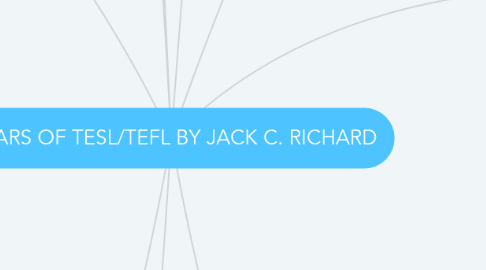
1. Authenticity in material
2. ROLE OF LEARNER
2.1. Role of motivation
2.1.1. Development of Human Values
2.1.2. Growth of Self-awarness
2.1.3. Empathy
2.2. Individualization
2.2.1. All Variables of Individual Differences
2.2.2. Learner-Centred Approaches
2.2.3. Learner-Centred Curriculum and Teaching
2.3. Learning Strategies
2.3.1. Controlled by Teachers
2.3.2. Students
2.3.3. Humanistic Approaches
2.3.4. Training of Learner Strategies
3. TEACHING FOUR SKILLS
3.1. Teaching Listening
3.1.1. Now
3.1.1.1. Learner as an active participants
3.1.1.2. Listening strategies
3.1.1.3. Varieties of accents
3.1.1.4. Bottom-up model
3.1.1.5. Top-down model
3.1.1.6. Comprehension viewed as the basis for acquisition
3.1.2. Then
3.1.2.1. Goal: Accurate recall of the information
3.1.2.2. Learner viewed as a passive participant
3.1.2.3. Decoding
3.1.2.4. Comprehension viewed as a demonstration of learning
3.1.2.5. Standard accent was of native speaker
3.1.2.6. Little discrimination between teaching and testing of listening
3.2. Teaching Speaking
3.2.1. Now
3.2.1.1. Speaking and oral interaction as the basic of learning
3.2.1.2. Globally communicative language
3.2.1.3. models based on corpus analysis
3.2.1.4. Functional and other type of communication syllabus
3.2.1.5. Accuracy was primary goal
3.2.1.6. Teacher fronted instruction predominated
3.2.2. Then
3.2.2.1. Speaking and oral interaction as the ways of mastering basic patterns and structure
3.2.2.2. property of native speaker
3.2.2.3. models based on author intiution
3.2.2.4. Grammatical and situational syllabus
3.2.2.5. Both accuracy and fluency are primary goal
3.2.2.6. Pair and group activities predominated
3.3. Teaching Reading
3.3.1. Then
3.3.1.1. Viewed as skill development
3.3.1.2. Text driven
3.3.1.3. Skills developed through graded and written text
3.3.1.4. decoding texts
3.3.1.5. Print materials and primary service for information
3.3.1.6. Literary reading skill
3.3.2. Now
3.3.2.1. Viewed as a mix of bottom-up and Top-down processing
3.3.2.2. Learner driven
3.3.2.3. Skills developed through the use of authentic texts
3.3.2.4. Creative and interactive process
3.3.2.5. Print material, hypertext and other source of information
3.3.2.6. Technical reading skill
3.4. Teaching Writing
3.4.1. Now
3.4.1.1. Peer feedback
3.4.1.2. Focus on composing processes
3.4.1.3. Focus on genres
3.4.1.4. Emphasis on effective writing
3.4.2. Then
3.4.2.1. Teacher feedback
3.4.2.2. Focus on grammar and sentence construction through immitating and practicing models
3.4.2.3. Product based approach
3.4.2.4. Emphasis on Personal writing
4. ASSESS STUDENTS' LEARNING
4.1. New Goals and Procedures
4.1.1. Qualities of Criterion-Referenced
4.1.2. Competency Based Assessments
4.1.3. Performance Tests
4.2. Self-Assessment
4.3. Alternative Assessment
4.3.1. Portfolio
4.3.2. Qualitative
4.3.3. Quantitative
4.3.4. Pear Assessment
4.3.5. Competence Based
4.3.6. Tests
4.3.7. Journals
4.3.8. Learner Diaries
5. PREPARING LANGUAGE TEACHERS
5.1. Second Language Teacher Education
5.1.1. Training Emphasized
5.1.2. Teachers Trained/Competence
5.1.3. Learn from Experts
5.2. Training and Development
5.2.1. Understanding of Different Styles of Teaching
5.2.2. New Strategies
5.2.3. Acquiring Skills of Mentor
5.2.4. Understanding SLA
6. GOAL OF TEACHING ENGLISH
6.1. Role of native speaker
6.1.1. Native-Speaker had privileged status
6.1.2. Phonological influence is a cultural trademark
6.1.3. RP Pronunciation is unattainable and unnecessary
6.2. English as an International Language
6.2.1. Globalization,
6.2.2. Trade and Commerce,
6.2.3. International Commodity,
6.2.4. Communication.
6.3. Purpose of Teaching English
6.3.1. then: politically neutral activity, educational and economical, empowerment.
6.3.2. now: expressions of cultures
6.4. Critical Perspectives
6.4.1. Political correctness/ CS
6.4.2. Underlying ideologies are examined
6.4.3. Linguistic imperialism/ CDA
6.4.4. comprehensibility is target
7. BEST WAY TO TEACH A LANGUAGE
7.1. Decline of methods
7.1.1. Audiolingualism is replaced by Communicative Language Teaching
7.1.2. New methods
7.1.3. Novel Method
7.1.4. Post methods= Processes
7.1.5. Action Research
7.1.6. Reflective Teaching
7.2. Communicative Approach
7.2.1. Communicative Competence
7.2.2. Fluency and Accuracy
7.2.3. Language Skills
7.2.4. Trial and Error
7.3. Context and Resources
7.3.1. Not Confined to Classroom
7.3.2. Internet IE Chatrooms
7.3.3. Technology
7.3.4. Language Lab
7.4. Influences from Corporate Sectors
7.4.1. Teaching Based on Books and Papers
7.4.2. Focus on Organizational Processes
7.4.3. Education Software is integral Part
8. ROLE OF GRAMMAR
8.1. Linguistic Competence to Communicative Competence
8.1.1. Linguistic Competence
8.1.2. Communicative Competence
8.2. Accuracy and Fluency
8.2.1. Grammar Based Methods
8.2.2. Communicative Methods
8.2.3. Accuracy Based
8.2.4. Fluency Based
8.2.5. Grammar Taught Out From Context
8.2.6. Into The Context
9. PROCESS INVOLVED IN SECOND LANGUAGE LEARNING
9.1. Second Language Acquisition
9.1.1. Interlanguage Concept
9.1.2. Role of Universal Graves
9.1.3. Error Analysis and SLA
9.1.4. Behaviourism
9.1.5. Interactionism
9.1.6. Creative Construction Hypothesis
9.1.7. Development Sequences
9.2. Information-Processing Models
9.2.1. Controlled Processing
9.2.2. Automatic Processing
9.2.3. Fluent
9.2.4. Less Fluent
9.3. Vygotsky's Theory
9.3.1. Information-Processing Models of Learning
9.3.2. Probablistic model of learning
9.3.3. Learning by scaffolding
9.3.3.1. Learning by scaffhold
